Listening Guide
| time | lead drum |
|---|---|
| 0:02 | theme 1A |
| 0:12 | theme 1B |
| 0:17 | theme 1C |
| 0:24 | theme 1D |
| 0:31 | theme 2A |
| 0:37 | theme 2B |
| 0:42 | theme 2C |
| 0:46 | theme 2A |
| 0:48 | theme 1A |
| 0:58 | theme 1B |
| 1:04 | theme 1C |
| 1:10 | theme 1D |
| 1:19 | theme 2A |
| 1:25 | theme 2B |
| 1:29 | theme 2C |
| 1:33 | theme 2A |
| 1:38 | theme 1A |
| 1:42 | theme 1B |
| 1:49 | to 3b Adavu, pt. 2 |
Fully Mixed Item
Mixer
Use the mixer controls to change instrument levels and skip to particular timestamps.
NOTE: We recommend not using Safari as it sometimes exhibits track synchronization problems.

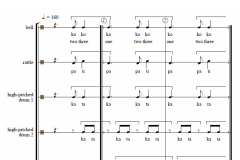
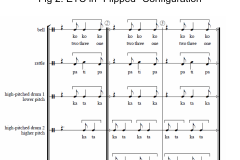
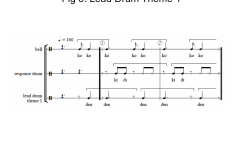
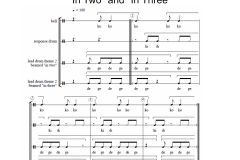
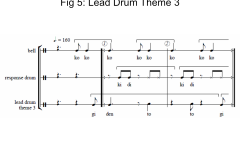
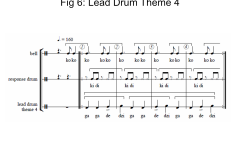
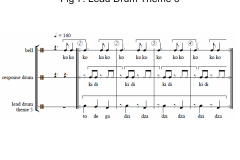
Performance Comment
This item was particularly challenging to do well in a multi-tracking situation for three reasons: first, the bell does not define a clear time span; second, the rhythm of high-pitched drum 1 and response drum theme 1 are supposed to be aligned in unison; and third, the lead drum’s transition to theme 2 is supposed to enable the response drummer to continue playing its “ki kidi” figure without change. This is hard enough to execute when all the parts of playing simultaneously. How much more challenging to play the lead drum correctly when only hearing the undifferentiated flow of the bell’s “ko ko ko ko”? The sequence of recording was bell, lead drum, response drum, and then high-pitched drum 1. So, how did it turn out? The first transition from theme 1D to theme 2A (0:31) went perfectly: I end my roll, lay out for one beat, and then play the “de degi” figure that brings in its echoing “ki kidi” response, literally, “without missing a beat!” At 0:48, the shift back to theme 1 also goes well; miraculously, I returned the response drum to theme 1 so that when I recorded the part for high-pitched drum 1 I did not need to make any adjustments. At 1:19, however, things did not turn out as seamlessly. When recording the response part, I needed to rather abruptly jump to theme 2 in the middle of a theme 1 phrase in order to properly answer the lead drum’s call; likewise, when recording the part for high-pitched drum 1, I had to quickly shift around so that its “ka kata” figure lined up with the “ki kidi” of the response drum. At least the alignment with bell, rattle and high-pitched drum 2 was unaffected, since their parts have no pattern shape. Similarly, when I shifted back to theme 1 at 1:38 I needed to do some quick adjustments on high-pitched drum 1 so to achieve correct alignment with response drum.
Listening back to the full mix recording, the alignment imperfections noted do not seem to spoil the music’s flow. Hopefully, only an expert who is intimately familiar with the tradition will be really disturbed by these imperfections.